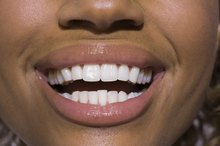Allergies to Tooth Fillings
Very few people experience allergic reactions to dental fillings, according to the American Dental Association 1. An allergy is an immune system reaction to a foreign substance. People with allergies to the materials used to make dental fillings may experience a localized reaction.
If you are experiencing serious medical symptoms, seek emergency treatment immediately.
Dental Fillings
Composite fillings combine quartz or glass in a resin medium. Translucent glass ionomers, which often are used to fill cavities on root surfaces, are made of fine glass powders and acrylic acids. Resin ionomers combine acrylic resin, acrylic acids and glass filler. Dentists also use fillings called indirect composites that are made in laboratories from dental composites.
- Composite fillings combine quartz or glass in a resin medium.
- Translucent glass ionomers, which often are used to fill cavities on root surfaces, are made of fine glass powders and acrylic acids.
Allergies
How to Care for Your Flipper
Learn More
Although most dental filling materials are considered biocompatible, or well-tolerated by dental patients, most can cause allergic reactions in some people. Porcelain fillings do not cause allergic reactions, according to the American Dental Association 1. Glass and resin ionomers very rarely cause allergic reactions. Some people, especially those with a family history of metal allergies, are allergic to one or more of the metals in amalgam fillings, while some are allergic to the elemental mercury used in dental amalgam or the metals used in porcelain-fused-to-metal fillings or base metal fillings.
- Although most dental filling materials are considered biocompatible, or well-tolerated by dental patients, most can cause allergic reactions in some people.
- Some people, especially those with a family history of metal allergies, are allergic to one or more of the metals in amalgam fillings, while some are allergic to the elemental mercury used in dental amalgam or the metals used in porcelain-fused-to-metal fillings or base metal fillings.
Reactions
Allergies to dental fillings cause reactions that occur near or at the site of the filling. An allergy to amalgam fillings may cause symptoms that resemble a skin allergy. The reaction might cause a rash or inflammation. Dental amalgam can cause oral lesions in people who are allergic to silver and other metals. Some patients require removal of dental fillings to alleviate the symptoms of allergic reaction.
- Allergies to dental fillings cause reactions that occur near or at the site of the filling.
- An allergy to amalgam fillings may cause symptoms that resemble a skin allergy.
Precautions
How to Remove Gold Teeth
Learn More
Your dentist can select the best dental filling for you if she is aware that you have allergies or that your family has a history of metal allergies. Some concerns about the elemental mercury in dental amalgam are not related to allergies but to the possibility of inhaling small amounts of mercury vapor from the fillings. The Food and Drug Administration, or FDA, considers the use of dental amalgam safe for adults and for children age 6 and older 2. However, the FDA recommends that pregnant and nursing women discuss concerns about dental amalgam with their doctors and dentists.
- Your dentist can select the best dental filling for you if she is aware that you have allergies or that your family has a history of metal allergies.
- However, the FDA recommends that pregnant and nursing women discuss concerns about dental amalgam with their doctors and dentists.
Related Articles
References
- American Dental Association: Amalgam – Dental Filling Options
- Food and Drug Administration; About Dental Amalgam Fillings; August 2009
- National Institutes of Health; Investigation of Contact Allergy to Dental Metals in 206 Patients; U. Raap, et al.; June 2009
- Jirau-Colon H, Conzalez-Parrilla L, Martinez-Jimenez J, et al. Rethinking the dental amalgam dilemma: An integrated toxicological approach. Int. J. Environ. Res. Public Health. 2019;16(6):1036. doi:https://doi.org/10.3390/ijerph16061036
- U.S. Food and Drug Administration. Dental Amalgam. Updated December 5, 2017
- American Dental Association (ADA). Statement on dental amalgam. 2016.
- Jirau-Colon H, Conzalez-Parrilla L, Martinez-Jimenez J, et al. Rethinking the dental amalgam dilemma: An integrated toxicological approach. Int. J. Environ. Res. Public Health. 2019;16(6):1036. doi:
Writer Bio
Gail Sessoms, a grant writer and nonprofit consultant, writes about nonprofit, small business and personal finance issues. She volunteers as a court-appointed child advocate, has a background in social services and writes about issues important to families. Sessoms holds a Bachelor of Arts degree in liberal studies.









